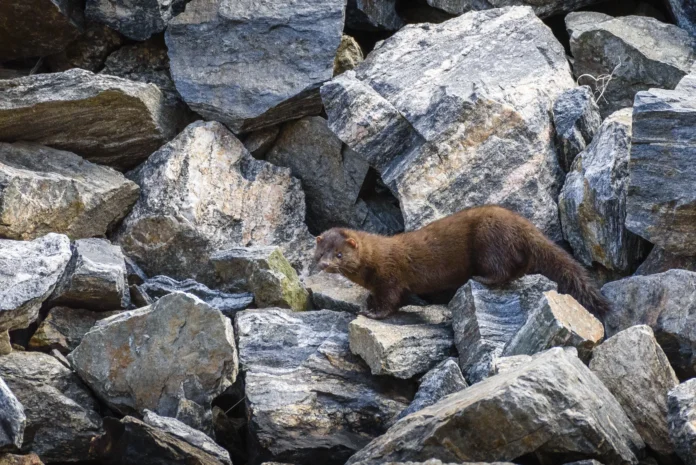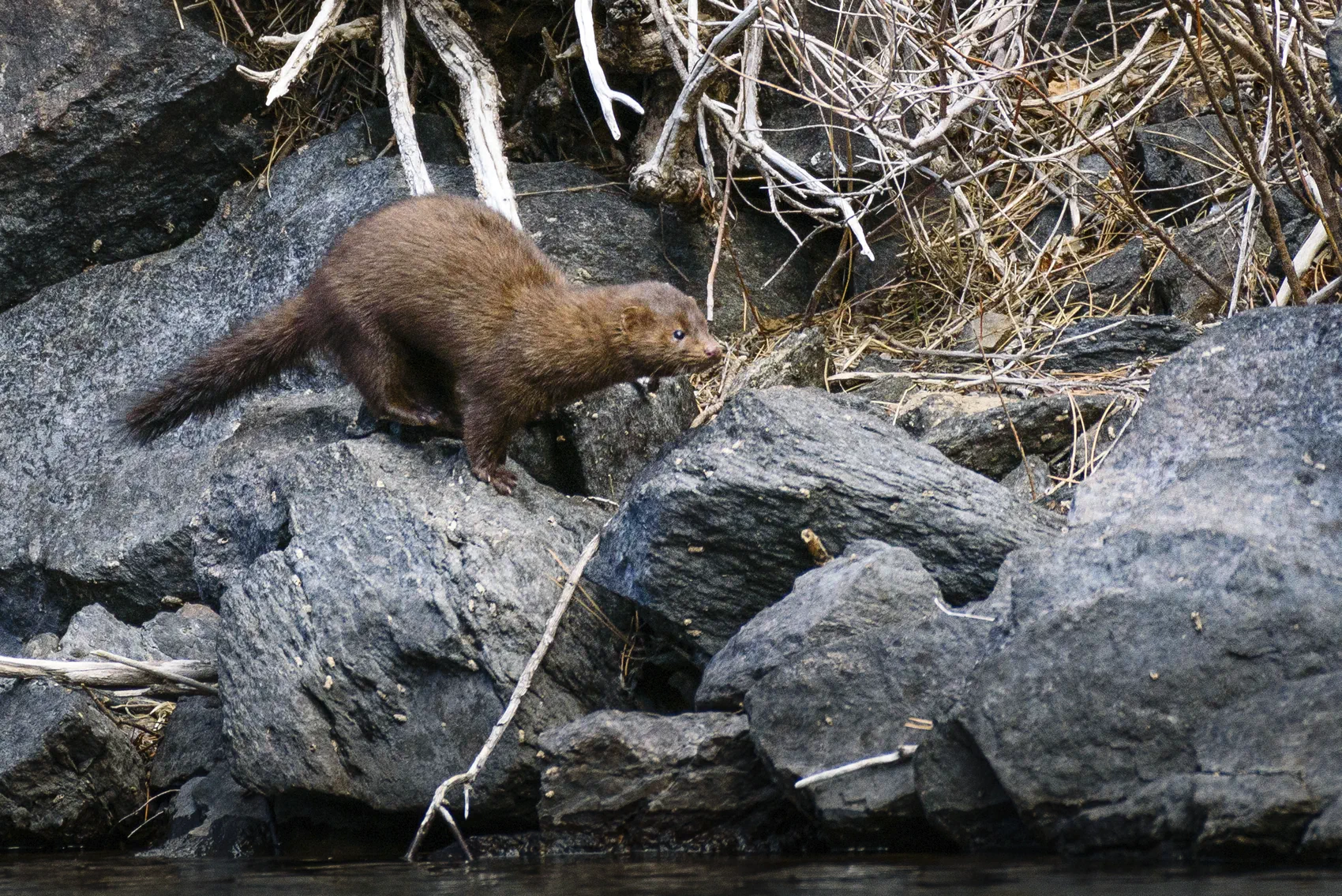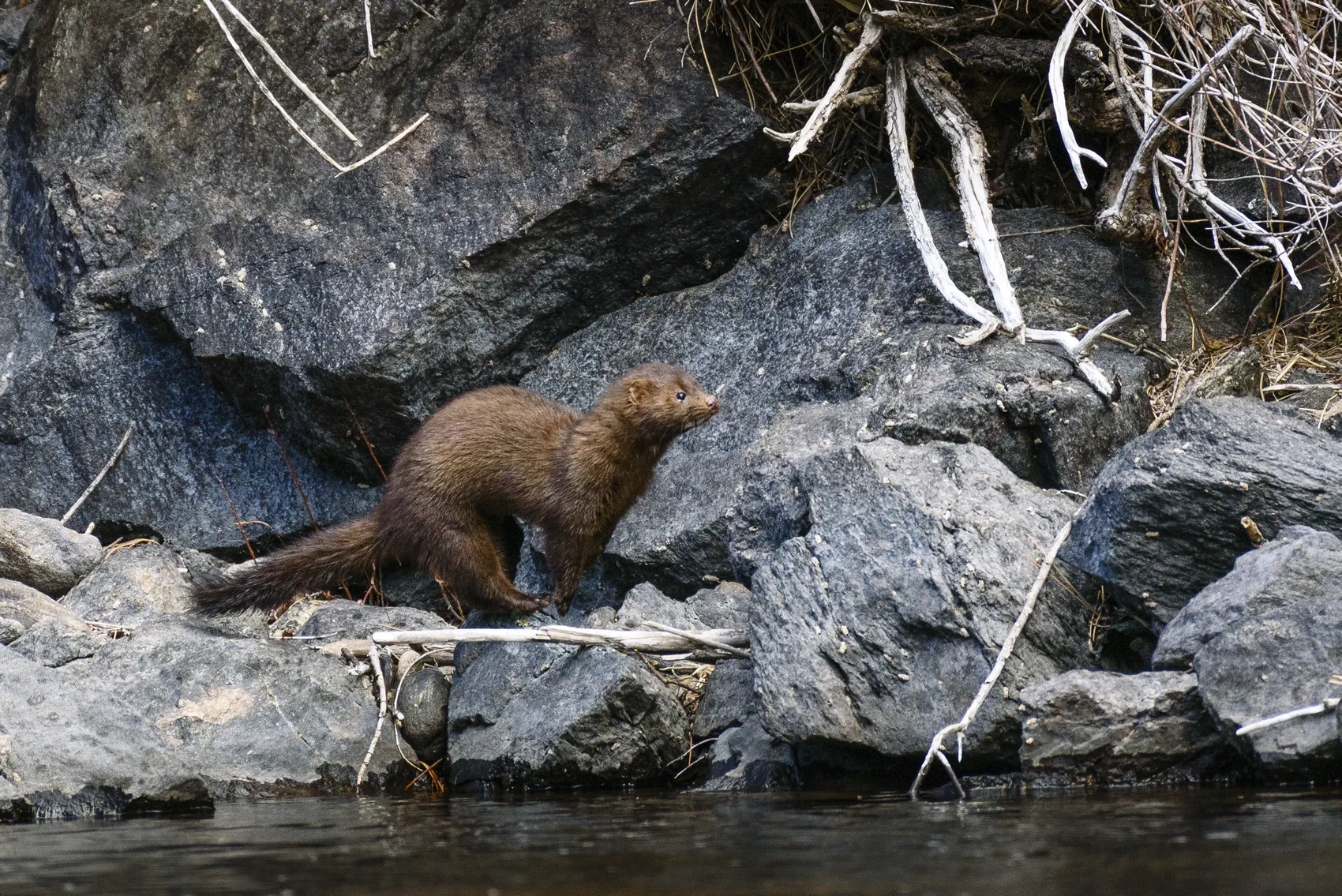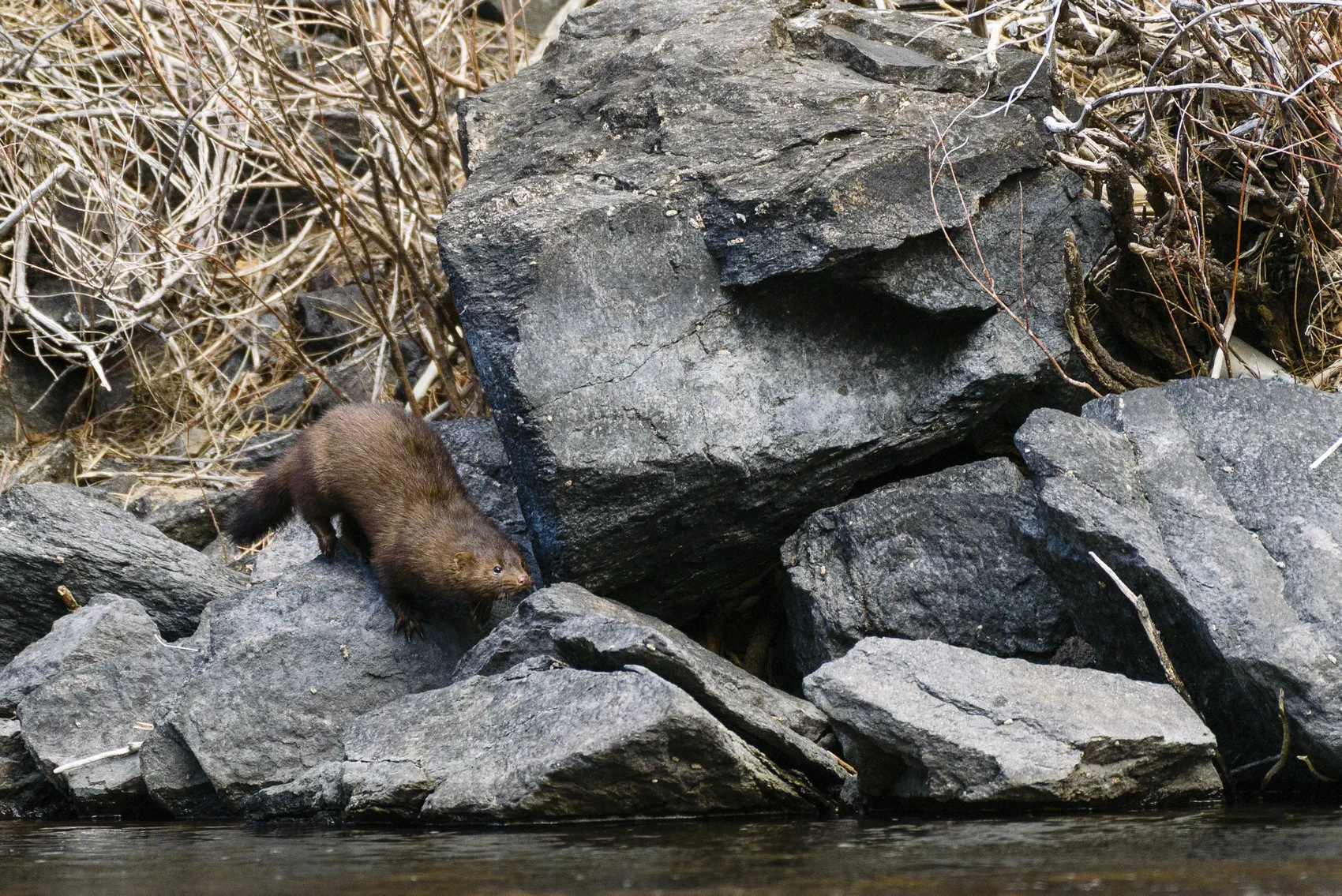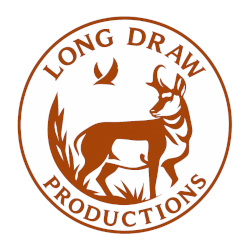On a cold morning along the Cache la Poudre, the river ran slate-green and fast, shouldered by boulders the size of cars. Between willow roots and tumbled rock, a brown body unspooled—short-legged, long-tailed, and all intent. The American mink (Neogale vison) doesn’t waste motion. It moves like a question mark, hugging edges, testing crevices for fish, frogs, or an unwary vole. When I made the photograph that anchors this piece, the animal paused and lifted its head just long enough for the shutter. Then it melted back into the seam between water and stone.
Mink are built for that seam. A double-layer pelt shrugs off cold. Narrow skull, needle teeth, partially webbed feet—everything about the species reads “semi-aquatic hunter.” Their home range is the riverbank itself: dens tucked behind root balls, under drift piles, inside rock voids left by spring flood. Where rivers still run cold and complex, mink usually persist.
Common, but not casual
The American mink is not a rare animal across its native North American range. It is still considered secure overall, though local declines can and do occur when wetlands are drained, river corridors are simplified, or water quality is compromised. “Common” can fool us; these animals are elusive by nature. You can walk a stream for years and never see one. Their presence shows up in sign: paired tracks on silt bars, a fish head neatly cleaned in a rock alcove, musky scat tucked beneath overhanging grass. For those who know how to read the river, the signal is there — but it’s changing.
The river is warming, the calendar is shifting
Colorado’s headwater streams are powered by snowmelt. When deep mountain snowpack melts gradually through spring, rivers like the Cache la Poudre stay cool and flowing into summer. But that clock is drifting. Winters are shorter, snow melts earlier, and summers run hotter and drier. Earlier runoff leaves the river warmer and lower when mink and their prey most need it. Fish retreat, amphibian breeding pools dry sooner, and aquatic life suffers under long stretches of low, warm water.
What a hotter, flashier river means for a mink
Mink are adaptable. They will eat trout one day, crayfish the next, and nestlings if they find a ground-level nest along a willow line. But even flexible predators have limits.
- Prey reliability: Warm water squeezes cold-adapted fish to deeper pockets or tributaries. Amphibian breeding ponds dry sooner. Crayfish persist but can be scoured out by extreme floods or stranded by drought.
- Den security: Low flows expose den entrances; intense storm bursts can undercut banks that once held for decades.
- Thermal refuge: Mink use riparian shade and bank cavities as cool hunting corridors. Loss of willow and cottonwood cover turns a shady ribbon into a hot, simplified edge.
These changes are no longer theoretical; they’re happening now across the Front Range.
Indicators in a fur coat
Mink play another role few people know about: they are indicators of river health. Because they feed high in the aquatic food chain and stay close to water, they accumulate pollutants and can reveal chemical stress in a watershed. Scientists have long studied mink to understand the impact of contaminants such as mercury and PCBs on reproduction and survival. When river flows shrink and heat up, pollution often becomes more concentrated, making mink a living signal of what’s happening below the surface.
Not just climate: the company rivers keep
Climate change isn’t the only challenge. Mink are affected by a long list of pressures:
- Channelization and bank hardening that erase burrow sites and simplify edges.
- Livestock grazing that removes willow and destabilizes banks.
- Heavy browsing from deer, elk, or moose that can collapse riparian vegetation.
- Legacy trapping that once reduced numbers in some areas.
- Invasive species and food web disruptions that make prey less reliable.
Mink conservation isn’t about saving a single species in isolation. It’s about keeping rivers dynamic, shaded, and clean.
The quiet engineers that buy mink time
Beavers may be one of mink’s best allies. Where beavers build, they slow and spread water, recharge floodplains, and create cool ponds. These ponds hold spring snowmelt through summer, keep fish and frogs around longer, and add undercut banks and root masses for dens. On drought-prone rivers, beaver activity can mean the difference between a trickle of warm water and a living corridor for predators like mink.
Managing for beaver-compatible reaches — relocating nuisance animals to suitable sites, using flow-control devices where conflict exists, and letting rivers keep their natural wood — is increasingly viewed as a cost-effective way to make watersheds resilient to climate swings.
How rare is the American mink—really?
On a continental scale, the American mink remains widespread and not considered threatened. Yet rarity isn’t only a global statistic. In some developed watersheds, you can have long gaps between sightings and individual animals defending oversized territories. A species can be “secure” on paper but functionally uncommon in a given river valley. That’s why documenting and protecting habitat before scarcity takes hold is so important.
What managers—and neighbors—can do
Keeping mink on the Cache la Poudre and similar rivers means focusing on the whole system:
- Protect floodplain connection. Allow high flows to reach benches and side channels.
- Retain wood and natural debris. These create dens and help food webs flourish.
- Grow and protect shade. Plant and safeguard willows and cottonwoods.
- Support beaver-based restoration. Beavers hold water and cool streams through heat and drought.
- Reduce contaminants. Cleaner runoff and less industrial pollution benefit the entire aquatic food chain.
- Plan for a changing hydrograph. Manage water to maintain summer baseflows where possible.
Field craft: finding your own mink
For those hoping to photograph or observe mink, think like the river:
- Work edges at first light. Move quietly and scan drift piles, rocks, and root tangles.
- Listen for small chaos. A crayfish splash, a soft chitter, or the rustle of prey being chased.
- Find repeating routes. Mink often patrol the same loops along a bank.
- Respect their space. If a mink notices and stamps at you, back off. Stress can drive it away from good habitat.
Why a single frame matters
The mink I photographed on the Cache la Poudre in 2017 is more than a wildlife moment. It’s a snapshot of an ecosystem at a specific point in time. If the same boulders are now exposed under a thinner flow, or if the willow line has receded, that image quietly documents change. Photographs can become environmental records — proof of what existed before shifting climate and human alteration.
The honest outlook
Hotter summers, earlier runoff, and more violent swings between drought and flood are here to stay. That reality will challenge mink, but it doesn’t doom them. Rivers are resilient when given room to move, shade to grow, and the engineers — like beavers — that keep them alive. If we manage for complexity and cool water, the American mink will keep slipping from shadow to shadow long after today’s climate headlines fade.
References and research
- NatureServe Explorer — American Mink (Neogale vison) conservation status
- IUCN Red List — American Mink: Green Status supplementary information (species overview)
- U.S. EPA — Climate Change Indicators: Snow & Ice (declining, earlier snowmelt in the West)
- Colorado Climate Assessment (2024) — Colorado Climate Center/Water Conservation Board
- Colorado Climate Assessment (2024) — Chapter on hazards, heat waves, drought, and runoff timing
- USGS WRI 03-4107 — Hydrology of the Cache la Poudre (snowmelt-dominated flows)
- CSU/NREL — “The Cache la Poudre River: From Snow to Flow” (hydrograph & snowmelt context)
- Basu et al. 2007 — Mink as a sentinel species in environmental health (mercury/PCBs)
- Bowman et al. 2012 — Contaminants in free-ranging domestic, wild, and hybrid mink
- Dittbrenner et al. 2022 — Beaver relocation increases water storage & reduces stream temperatures
- Stevenson et al. 2022 — Beaver pond effects on stream temperature (meta-analysis)
- American Rivers 2024 — Low-Tech Process-Based Restoration (BDAs/wood additions & flow cooling)

